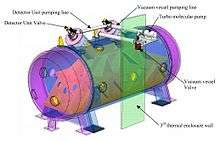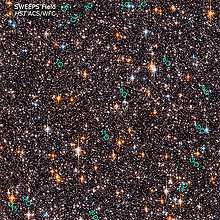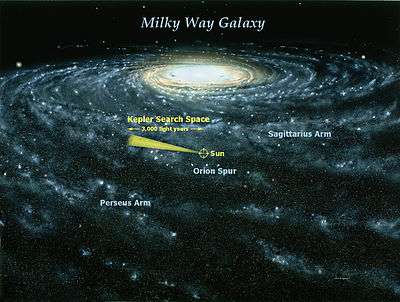ESPRESSO
ESPRESSO (Echelle Spectrograph for Rocky Exoplanet- and Stable Spectroscopic Observations)[1] is a third-generation, fiber fed, cross-dispersed, echelle spectrograph mounted on the European Southern Observatory's Very Large Telescope (VLT). The unit saw its first light on September 25, 2016.[2][3]


ESPRESSO is the successor of a line of echelle spectrometers that include CORAVEL, Elodie, Coralie, and HARPS. It measures changes in the light spectrum with great sensitivity, and is being used to search for Earth-size rocky exoplanets via the radial velocity method. For example, Earth induces a radial-velocity variation of 9 cm/s on the Sun; this gravitational "wobble" causes minute variations in the color of sunlight, invisible to the human eye but detectable by the instrument.[4] The telescope light is fed to the instrument, located in the VLT Combined-Coude Laboratory 70 meters away from the telescope, where the light from up to four unit telescopes of the VLT can be combined. The Principal Investigator is Francesco Pepe.
Sensitivity

ESPRESSO builds on the foundations laid by the High Accuracy Radial Velocity Planet Searcher (HARPS) instrument at the 3.6-metre telescope at ESO's La Silla Observatory. ESPRESSO benefits not only from the much larger combined light-collecting capacity of the four 8.2-metre VLT Unit Telescopes, but also from improvements in the stability and calibration accuracy that are now possible by laser frequency comb technology. The requirement is to reach 10 cm/s,[6] but the aimed goal is to obtain a precision level of a few cm/s. This would mean a large step forward over current radial-velocity spectrographs like ESO's HARPS. The HARPS instrument can attain a precision of 97 cm/s (3.5 km/h),[7] with an effective precision of the order of 30 cm/s,[8] making it one of only two spectrographs worldwide with such accuracy. The ESPRESSO would greatly exceed this capability making detection of Earth-size planets from ground-based instruments possible. Commissioning of ESPRESSO at the VLT started late 2017.
The instrument is capable of operating in 1-UT mode (using one of the telescopes) and in 4-UT mode. In 4-UT mode, in which all the four 8-m telescopes are connected incoherently to form a 16-m equivalent telescope, the spectrograph detects extremely faint objects.[4][9]
For example, for G2V type stars:
- Rocky planets around stars as faint as V ≈ 9 in (in 1-UT mode)
- Neptune mass planets around stars as faint as V ≈ 12 (in 4-UT mode )
- Earth-size rocky planets around stars as faint as V ≈ 9 (CODEX on the E-ELT) [10]
The best-suited candidate stars for ESPRESSO are non-active, non-rotating, quiet G dwarfs to red dwarfs. It operates at the peak of its efficiency for a spectral type up to M4-type stars.
Instrument

For calibration, ESPRESSO uses a laser frequency comb (LFC), with backup of two ThAr lamps. It features three instrumental modes: singleHR, singleUHR and multiMR. In the singleHR mode ESPRESSO can be fed by any of the four UTs.[12]
Status

All design work was completed and finalised by April 2013, with the manufacturing phase of the project commencing thereafter.[1] ESPRESSO was tested on June 3, 2016.[14] ESPRESSO first light occurred on September 25, 2016, during which they spotted various objects, among them the star 60 Sgr A.[2][3] After being shipped to Chile, installed at the VLT, ESPRESSO saw its first light there on 27 November 2017, in 1-UT mode, observing the star Tau Ceti;[15][16][17] the first star observed in the 4-UT mode was on February 3, 2018.[18][19][20]
ESPRESSO has been opened to the astronomical community in the 1-UT mode (one single telescope used), and is producing scientific data since October 24, 2018. On quiet stars it has already demonstrated radial-velocity precision of 25 cm/s over a full night. However, there have been some problems, for example, in light collecting efficiency which was around 30% lower than expected and required. And so, some fine-tuning, including replacing the parts causing the efficiency problem and subsequent re-testing, were to be done on the instrument before the full 4-UT mode was open to the scientific community in April 2019.[21] A problem was discovered in the ESPRESSO charge-coupled device controllers, digital imaging hardware, where a differential nonlinearity issue has reduced the resolution obtainable more severely than was previously feared. The ESO detector team that determined the source of the problem is currently, as of June 2019, working on a new version of the associated hardware in order to remedy this hopefully temporary setback.[22]
On Aug 29, 2019, the ESPRESSO ETC was updated to reflect the gain in transmission after the technical mission of July. This gain influx was, on average, ≈50% in the UHR and HR modes and ≈40% in the MR.[23]
As of April 6, 2020, the red radial velocity detector has, at least for a very short time, achieved the ≈10 cm/s precision, while the blue detector has so far only managed ≈60 cm/s. The ESPRESSO operator and detector teams are working to characterize and correct the problem, with a dedicated mission expected to take place during 2020.[24]
On May 24, 2020, a team-leading by A. Suárez Mascareño confirmed the existence of Proxima b they also found that it is 1.17 times the mass of Earth, smaller than the older estimate of 1.3 times and is located in the habitable zone of its star, which it orbits in 11.2 days. ESPRESSO achieved an accuracy of 30 centimeters a second (cm/s) or about three times more precise than that obtained with HARPS. They also found a second signal in the data that could be of planetary origin. [25] [26]
Scientific objectives
The main scientific objectives for ESPRESSO are:[27][28]
- The measurement of high precision radial velocities of solar type stars for the search for rocky planets in the habitable zone of their star.
- The measurement of the variation of the physical constants
- The analysis of the chemical composition of stars in nearby galaxies.
Consortium
ESPRESSO is being developed by a consortium consisting on the European Southern Observatory (ESO) and seven scientific institutes:
- Centre for Astrophysics of the University of Porto (Portugal)
- Faculdade de Ciências da Universidade de Lisboa, CAAUL & LOLS (Portugal)
- Trieste Astronomical Observatory (Italy)
- Brera Astronomical Observatory (Italy)
- Instituto de Astrofísica de Canarias (Spain)
- Physics Institute of the University of Bern (Switzerland)
- University of Geneva (Switzerland)
- Institute of Astrophysics and Space Sciences (Portugal)
ESPRESSO specifications
| ESPRESSO | |||
|---|---|---|---|
| Telescope | VLT (8m) | ||
| Scope | Rocky planets | ||
| Sky aperture | 4 arcsec | ||
| R | ≈200.000 | ||
| λ coverage | 380 nm-686 nm[29] | ||
| λ precision | 5 m/s | ||
| RV stability | < 10 cm/s | ||
| 4-VLT mode (D = 16 m) with RV = 1 m/s | |||
| Source:[10][30][28] | |||
Radial velocity comparison tables
| Planet Mass | Distance AU |
Radial velocity (vradial) |
Note |
|---|---|---|---|
| Jupiter | 1 | 28.4 m/s | |
| Jupiter | 5 | 12.7 m/s | |
| Neptune | 0.1 | 4.8 m/s | |
| Neptune | 1 | 1.5 m/s | |
| Super-Earth (5 M⊕) | 0.1 | 1.4 m/s | |
| Alpha Centauri Bb (1.13 ± 0.09 M⊕) | 0.04 | 0.51 m/s | (1[31]) |
| Super-Earth (5 M⊕) | 1 | 0.45 m/s | |
| Earth | 0.09 | 0.30 m/s | |
| Earth | 1 | 0.09 m/s | |
| Source: Luca Pasquini, power-point presentation, 2009[10] Notes: (1) Most precise vradial measurements ever recorded. ESO's HARPS spectrograph was used.[31][32] | |||
| Planet | Planet Type |
Semimajor Axis (AU) |
Orbital Period |
Radial velocity (m/s) |
Detectable by: |
|---|---|---|---|---|---|
| 51 Pegasi b | Hot Jupiter | 0.05 | 4.23 days | 55.9[33] | First-generation spectrograph |
| 55 Cancri d | Gas giant | 5.77 | 14.29 years | 45.2[34] | First-generation spectrograph |
| Jupiter | Gas giant | 5.20 | 11.86 years | 12.4[35] | First-generation spectrograph |
| Gliese 581c | Super-Earth | 0.07 | 12.92 days | 3.18[36] | Second-generation spectrograph |
| Saturn | Gas giant | 9.58 | 29.46 years | 2.75 | Second-generation spectrograph |
| Proxima Centauri b | Habitable planet (potentially) | 0.05 | 11.19 days | 1.38[37] | Second-generation spectrograph |
| Alpha Centauri Bb | Terrestrial planet | 0.04 | 3.23 days | 0.510[38] | Second-generation spectrograph |
| Neptune | Ice giant | 30.10 | 164.79 years | 0.281 | Third-generation spectrograph |
| Earth | Habitable planet | 1.00 | 365.26 days | 0.089 | Third-generation spectrograph (likely) |
| Pluto | Dwarf planet | 39.26 | 246.04 years | 0.00003 | Not detectable |
MK-type stars with planets in the habitable zone
| Stellar mass (M☉) |
Planetary mass (M⊕) |
Lum. (L0) |
Type | RHAB (AU) |
RV (cm/s) |
Period (days) |
|---|---|---|---|---|---|---|
| 0.10 | 1.0 | 8×10−4 | M8 | 0.028 | 168 | 6 |
| 0.21 | 1.0 | 7.9×10−3 | M5 | 0.089 | 65 | 21 |
| 0.47 | 1.0 | 6.3×10−2 | M0 | 0.25 | 26 | 67 |
| 0.65 | 1.0 | 1.6×10−1 | K5 | 0.40 | 18 | 115 |
| 0.78 | 2.0 | 4.0×10−1 | K0 | 0.63 | 25 | 209 |
| Source:[39][40] | ||||||
See also
| Wikimedia Commons has media related to ESPRESSO. |
- CODEX spectrograph
- CORALIE spectrograph
- Doppler spectroscopy
- ELODIE spectrograph
- EXPRES spectrograph
- HIRES spectrograph
- List of extrasolar planets
- SOPHIE échelle spectrograph
References
- "ESO - Espresso". Retrieved 2012-10-24.
- http://www.eso.org/public/usa/announcements/ann16073/ ESPRESSO Sees Light at the End of the Tunnel
- http://www.media.inaf.it/2016/10/17/prima-luce-espresso-coude-lab/ ESPRESSO vede la luce in fondo al “tunnel”
- "ESPRESSO - Searching for other Worlds". Centro de Astrofísica da Universidade do Porto. 2010-10-16. Archived from the original on 2010-10-17. Retrieved 2010-10-16.
- "First Light for ESPRESSO — the Next Generation Planet Hunter". www.eso.org. Retrieved 7 December 2017.
- Pepe, F.; Molaro, P.; Cristiani, S.; Rebolo, R.; Santos, N. C.; Dekker, H.; Mégevand, D.; Zerbi, F. M.; Cabral, A.; et al. (January 2014). "ESPRESSO: The next European exoplanet hunter". Astronomische Nachrichten. 335 (1): 8–20. arXiv:1401.5918. Bibcode:2014arXiv1401.5918P. doi:10.1002/asna.201312004.
- "32 planets discovered outside solar system". CNN. 19 October 2009. Retrieved 4 May 2010.
- "ESPRESSO – Searching for other Worlds". Centro de Astrofísica da Universidade do Porto. 16 December 2009. Archived from the original on 17 October 2010. Retrieved 16 October 2010.
- Pepe, Francesco A; Cristiani, Stefano; Rebolo Lopez, Rafael; Santos, Nuno C; et al. (July 2010). "ESPRESSO: the Echelle spectrograph for rocky exoplanets and stable spectroscopic observations" (PDF). Ground-based and Airborne Instrumentation for Astronomy III. 7735. American Institute of Physics. p. 77350F. Bibcode:2010SPIE.7735E..0FP. doi:10.1117/12.857122. Retrieved 2013-03-12.
- "ESPRESSO and CODEX the next generation of RV planet hunters at ESO". Chinese Academy of Sciences. 2010-10-16. Archived from the original on July 4, 2011. Retrieved 2010-10-16.
- "ESO's VLT Working as 16-metre Telescope for First Time - ESPRESSO instrument achieves first light with all four Unit Telescopes". www.eso.org. Retrieved 13 February 2018.
- https://arxiv.org/abs/1401.5918 ESPRESSO: The next European exoplanet hunter
- "ESO Awards Contracts for Cameras for New Planet Finder". ESO Announcement. Retrieved 8 August 2013.
- https://obswww.unige.ch/wordpress/espresso/2016/06/04/espresso-first-laboratory-light/
- http://www.eso.org/public/unitedkingdom/announcements/ann17053/ ESPRESSO Planet Hunter Heads for Chile
- https://phys.org/news/2017-12-espressothe-planet-hunter.html
- Vonarburg, Barbara (2017-12-07). "First light of ESPRESSO". NCCR PlanetS. National Centre of Competence in Research PlanetS. Retrieved 2018-11-07.
The first observation was for the star Tau Ceti. It was done using the UT1 of the VLT, the observations made on the four united telescopes will be done later.
- https://www.eso.org/public/unitedkingdom/news/eso1806/ ESO’s VLT Working as 16-metre Telescope for First Time
- Bratschi, Pierre (2018-02-14). "ESPRESSO: first time with the 4 UTs of the VLT". NCCR PlanetS. National Centre of Competence in Research PlanetS. Retrieved 2018-11-07.
... first light of ESPRESSO with the four VLT 8.2-meter Unit Telescopes (4UT mode) took place on Saturday February 3rd, 2018... star observed by ESPRESSO with the 4UT mode was the so-called Pepe star
- Echelle SPectrograph for Rocky Exoplanet and Stable Spectroscopic Observations, ESO
- Barbara, Vonarburg (2018-11-28). "Fine-tuning Espresso". NCCR PlanetS. National Centre of Competence in Research PlanetS. Retrieved 2018-12-28.
ESPRESSO has been opened to the astronomical community and finally started operations on the 24th of October 2018.
- "ESPRESSO News and Press Releases". European Southern Observatory. 2019-06-05. Retrieved 2019-06-21.
An issue with the ESPRESSO CCD controllers has recently been identified.
- "ESO - News". www.eso.org. Retrieved 2019-11-12.
- "ESO - News". www.eso.org. Retrieved 2020-04-11.
- Suárez Mascareño, A.; Faria, J. P.; Figueira, P.; Lovis, C.; Damasso, M.; González Hernández, J. I.; Rebolo, R.; Cristiano, S.; Pepe, F.; Santos, N. C.; Zapatero Osorio, M. R.; Adibekyan, V.; Hojjatpanah, S.; Sozzetti, A.; Murgas, F.; Abreo, M.; Affolter, M.; Alibert, Y.; Aliverti, M.; Allart, R.; Allende Prieto, C.; Alves, D.; Amate, M.; Avila, G.; Baldini, V.; Bandi, T.; Barros, S. C. C.; Bianco, A.; Benz, W.; et al. (2020). "Revisiting Proxima with ESPRESSO". arXiv:2005.12114 [astro-ph.EP].
- https://www.aanda.org/component/article?access=doi&doi=10.1051/0004-6361/202037745 Revisiting Proxima with ESPRESSO
- ESPRESSO - A VLT Project. Accessed 12 October 2017.
- ESPRESSO Baseline Specification. European Southern Observatory (ESO). Accessed: 12 October 2017
- ESPRESSO. ESO.
- Pepe, F; Molaro, P; Cristiani, S; Rebolo, R; et al. (2014). "ESPRESSO: The next European exoplanet hunter". arXiv:1401.5918v1 [astro-ph.IM].
- "Planet Found in Nearest Star System to Earth". European Southern Observatory. 16 October 2012. Retrieved 17 October 2012.
- Demory, Brice-Olivier; Ehrenreich, David; Queloz, Didier; Seager, Sara; et al. (25 March 2015). "Hubble Space Telescope search for the transit of the Earth-mass exoplanet Alpha Centauri Bb". Monthly Notices of the Royal Astronomical Society. 450 (2): 2043–2051. arXiv:1503.07528. Bibcode:2015MNRAS.450.2043D. doi:10.1093/mnras/stv673.
- "51 Peg b". Exoplanets Data Explorer.
- "55 Cnc d". Exoplanets Data Explorer.
- Endl, Michael. "The Doppler Method, or Radial Velocity Detection of Planets". University of Texas at Austin. Retrieved 26 October 2012.
- "GJ 581 c". Exoplanets Data Explorer.
- "Proxima Cen b". The Extrasolar Planets Encyclopaedia.
- "alpha Cen B b". Exoplanets Data Explorer.
- "An NIR laser frequency comb for high precision Doppler planet surveys". Chinese Academy of Sciences. 2010-10-16. Retrieved 2010-10-16.
- Osterman, S; Diddams, S; Quinlan, F; Bally, J; Ge, J; Ycas, G (2010). "A near infrared laser frequency comb for high precision Doppler planet surveys". EPJ Web of Conferences. 16: 02002. arXiv:1003.0136. Bibcode:2011EPJWC..1602002O. doi:10.1051/epjconf/20111602002.


